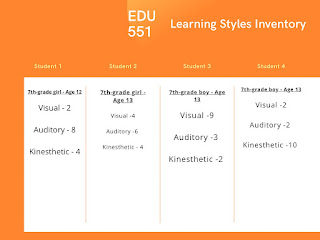EDU 551 Differentiation Lesson Plan.
EDU 551 - Diffrented lesson
I chose this lesson because it was one of my favorite lessons and offered many different ways in which I need to differentiate for my students. In the past, my lower-level students have done well in classes, but the gifted students have struggled. I foolishly thought you give the more intelligent students more work, that is not true. There are many ways to let gifted students learn. "Bright students often need space to move around when they are thinking. If your group of students is well-behaved and the classroom is big enough, designate a few minutes every lesson for movement." (Classful, 2009). I use this strategy daily in my classroom. These students know they have the freedom to get up and move; they primarily work with the lower-level students to help them. The school recommends the strategies I choose for ELL students or what their IEPs require. I knew that interest in poetry was going to be low, so I decided to focus this unit on analyzing and studying poetry vs. the students writing poetry. We will get to writing poetry next semester.
When planning a lesson, it is always essential that you plan backward. Planning backward means I start with my end goal and work back to ensure all my instruction is headed towards that goal. For this lesson, the end goal is: Students should be able to analyze a poem. So everything I teach during this unit should complement that goal. I have one ELL student and one student who has visual impairments in my class. With the ELL student, I continually model everything I do. I "model for students what they are expected to do or produce, especially for new skills or activities, by explaining and demonstrating the learning actions, sharing your thinking processes aloud, and showing good teacher and student work samples." (Edutopia, 2016) With my ELL student, I always provide printed-off notes for her that include more straightforward wording and pictures to help guide her. For visually impaired students, notes are always printed off and enlarged.
For this intro to a poetry unit, this was the first day. The first lesson is crucial to setting the tone for the whole unit. If the students don't grasp the concept here, it will be a struggle for the rest of the unit, or I will need to spend more time here before moving on. The central technology being used was their Chromebooks. My ELL student has numerous programs on her Chromebook she uses; the aide in charge of her learning is constantly looking for new ones, as am I. Technology for ELL students is crucial for her to use daily, especially since our district can't afford a one-on-one for her. "From basic translation to productivity tools for consumers, a lot of everyday apps and websites can be great for supporting ELL-centered learning activities." Common Sense, 2020). My ELL student is at the point where she is already checking the resources she has access to while I am going through the instruction. One of my main goals is to speak slowly and clearly to help her process the information.
References
16 Tips for Teaching Gifted Students. Accessed December 5, 2021. https://classful.com/16-tips-for-teaching-gifted-students/ Classful. August, 2009
Do's & Don'ts for Teaching English-Language Learners. Accessed December 5, 2021. https://www.edutopia.org/blog/esl-ell-tips-ferlazzo-sypnieski. Edutopia. November, 2016.
How to Use Technology to Support ELLs in Your Classroom. Accessed December 6, 2021. https://www.commonsense.org/education/articles/how-to-use-technology-to-support-ells-in-your-classroom. Common Sense Education. July 2021.

Comments
Post a Comment